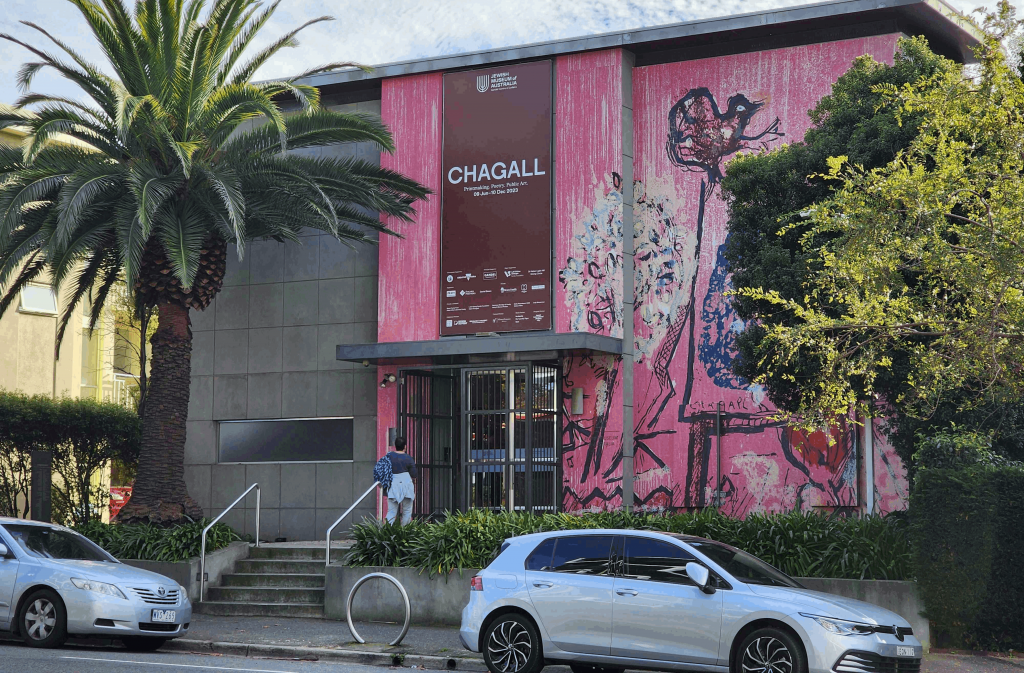Jade Niklai
Exhibition Curator
CHAGALL, a unique exhibition dedicated to Marc Chagall’s practice in printmaking, poetry and public art, celebrates one of the great masters of the 20th century.
He was born in 1887 in Vitebsk, in the Russian Empire; the eldest of nine children to mother Feige Ite, a shop keeper and father Khatskl Shagal, a herring merchant.
Deeply affected by his experience as a Jew of 20th Century Europe, Chagall is widely known for his paintings of Shtetl* life (*Yiddish word for small Jewish towns in Eastern Europe before the Holocaust). His art reminds us of a world that no longer exists, evoking a nostalgia that encapsulates many Jewish émigrés’ experience.
Through this exhibition, CHAGALL offers a journey from printmaking on paper, through to the intimacy of illustrated poetry and the grandness of his public art commissions.
His early, smaller works reflect home and heritage with images of Shtetl life. Working with candlelight in the dimly lit homes of the time, the detail is intricate, revealing much about his inner life and psychological mindset. The colour palette is muted with plenty of blues and browns; the latter being the cheapest paint a poor artist could afford.
By the time Chagall arrives in Paris, he is transformed by the world and experiences around him, and he starts to experiment with colour, shape and form. Recurrent themes of Paris monuments, flowers and nature begin to appear in his work. Chagall always believed Paris was where he belonged and, when he arrived, it lived up to his expectations.
While Chagall’s experience of working in theatre began with disappointment in Russia, it set the foundations for his later commission at the Paris Opera House and other public art projects around the world.
His artistic practice consistently explored humanity through the mostly female form. From yearning for mother to sexual desire, Chagall’s perception of the human condition is elevated by his public art commissions; where the physical form evolves to the spiritual. Returning to his Jewish roots, Chagall comes full circle with his most accomplished, uniquely Jewish public artwork: the 12-part Hadassah stained-glass windows, which are presented here for the first time to Australian audiences.
Chagall was the penultimate Wandering Jew; perpetually searching for meaning and purpose through his art-making. Granted a long life of 97 years, he was afforded the opportunity to mature as an artist. His legacy culminated with a French national museum which opened 12 years before his death in 1985, and countless acquisitions and continual exhibitions are dedicated to his art worldwide.
The exhibition, design by Anna Tregloan, invites a deeper experience of Chagall’s theatrical practice.
CHAGALL at the Jewish Museum of Australia: Gandel Centre of Judaica pays tribute to the Museum’s visionary founding director, the late Dr Helen Light AM and her 1995 exhibition Chagall and the Bible.
The exhibition is enhanced by an ongoing series of public programs and the Museum’s inaugural Contemporary Australian Art Commission by Melbourne-based creative practitioner and Archibald Prize-winning artist, Yvette Coppersmith, with the generous support of Daniel Besen.
CHAGALL will run at the Jewish Museum of Australia from 09 June—10 December. Tickets are available here.
Image: Sarah Giles, Jewish Museum of Australia facade featuring Si Mon Soleil (If my Sun), 1968, © Marc Chagall, ADAGP/Copyright Agency, 2023
